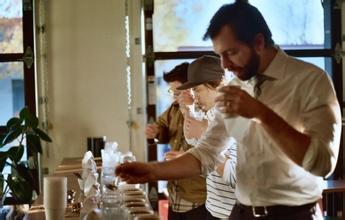Key points of World Coffee knowledge: analysis of Acid components in Coffee; where does caffeic acid come from?
The acidity of coffee is usually considered to be related to the quality of coffee. Acidity is typical of high-value coffee in Central America and East Africa. Excessive sour taste is considered to be the disadvantage of coffee. Acidity is related to growing at very high altitudes and mineral-rich volcanic soils.
The acidity of washed beans is higher than that of sun-dried beans. For example, the concentration of sun-dried beans is heavier than that of washed beans, because the concentration obscures the acidity of coffee. The acid substance of coffee beverage is closely related to the degree of baking, as well as the method of baking and brewing. PH of coffee is also related to the acidity of coffee. The pH value of a good cup of coffee should be between 4.9 and 5.2.
Coffee raw beans and roasted beans contain more than 100 acids. Chlorogenic acid and quinic acid are the main acid substances in raw beans, followed by malic acid and limonic acid. Chlorogenic acid complexes are degraded into smaller components during baking, forming components such as acetic acid and formic acid. Because of the high volatility of these ingredients, they disappeared in the subsequent baking stage.
Chlorogenic acid
Chlorogenic acid is actually an ester component between quinic acid and phenols like cinnamic acid. The most common coffee is coffee quinic acid (5-O-caffeoylquinic acid), an ester between quinic acid and caffeic acid. More than 17 different chlorogenic acids have been found in Robusta raw beans, but the amount of chlorogenic acid seems to vary depending on origin and coffee variety.
Caffeic acid
Coffee provides the richest dietary source of chlorogenic acid. According to the report, a cup of 200cc coffee contains 70-350 mg chlorogenic acid and will supply 35-175 mg caffeic acid. The chlorogenic acid in coffee has the effect of maintaining health. Although chlorogenic acid and caffeic acid have antioxidant effects in test tubes, the exact amount of antioxidant activity is unknown because they are widely metabolized in the body, and their metabolites often have lower antioxidant activity than predecessor substances.
Caffeic acid exists not only in coffee, but also in a large number of edible and inedible plants. With antioxidants. On the other hand, current research suggests that caffeic acid may also be a carcinogen. The health benefits of caffeic acid are unknown.

Source: platinum Coffee College
Important Notice :
前街咖啡 FrontStreet Coffee has moved to new addredd:
FrontStreet Coffee Address: 315,Donghua East Road,GuangZhou
Tel:020 38364473
- Prev

Key points of World Coffee knowledge: introduction to SCAA Cup Test and explanation of Standard rules
According to the SCAA standard, the cup test baked beans should be medium baked (see SCAA Baking Swatch 55), the cup test sample baking time should be between 8-12 minutes, can not be scorched, or there is a focus. Cool quickly after baking and keep airtight in a cool place. Place for at least 8 hours after baking, but cup testing must be carried out within 24 hours after baking. In other words, bake the beans at 12:00 and test the cup.
- Next

Main points of coffee knowledge: CoE excellent cup coffee cup scoring standard is explained in detail
At present, the competition of fine beans in various countries adopts either CoE or SCAA mode, and up to 9 major coffee producing countries adopt Coe cup as the national competition mode. The following is the key description of the Coe Cup meter evaluation items and records, which can give you a basic basis when conducting a cup test, as well as an auxiliary reference when testing a single item: Aroma is the first evaluation at the beginning of the cup test.
Related
- What is the meaning of lactic acid fermentation with coffee bean treatment?
- How to judge the state of foam by sound?
- How does the latte pull out the unicorn pattern? Come to get for a little trick to improve the flower pull!
- Will flower pulling affect the taste of the latte?
- Do you know the history of coffee?
- The difference between honey treatment and sun washing what is raisin honey treatment?
- What kind of milk can a novice use to make coffee foam to keep the foam longer? The correct method and skills of milking tutorial sharing
- Why do washed coffee beans taste sour? Flavor characteristics of washed Coffee
- Introduction to the skill of how to practice the size and height of water injection around the circle of hand-brewed coffee
- How do beginners practice coffee flower drawing from scratch?

